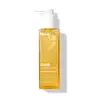What's inside
What's inside
 Key Ingredients
Key Ingredients

 Benefits
Benefits

 Concerns
Concerns

 Ingredients Side-by-side
Ingredients Side-by-side

Water
Skin ConditioningDecyl Glucoside
CleansingCocamidopropyl Betaine
CleansingHydroxypropyl Starch Phosphate
Butylene Glycol
HumectantGlycolic Acid
BufferingGlycerin
HumectantMandelic Acid
Antimicrobial1,2-Hexanediol
Skin ConditioningSodium Hydroxide
BufferingSodium Chloride
MaskingTromethamine
BufferingAmorphophallus Konjac Root Powder
AbrasiveGluconolactone
Skin ConditioningCitrus Junos Fruit Extract
Skin ConditioningAnanas Sativus Fruit Extract
Skin ConditioningSalix Alba Bark Extract
AstringentHamamelis Virginiana Extract
AntiseborrhoeicLactobacillus/Rice Ferment
Skin ConditioningBifida Ferment Lysate
Skin ConditioningSalvia Officinalis Leaf Extract
CleansingSodium Hyaluronate
HumectantHyaluronic Acid
HumectantHydrolyzed Hyaluronic Acid
HumectantHydrolyzed Sodium Hyaluronate
Skin ConditioningHydroxypropyltrimonium Hyaluronate
Potassium Hyaluronate
Skin ConditioningSodium Acetylated Hyaluronate
HumectantZinc PCA
HumectantMaltitol
HumectantAllantoin
Skin ConditioningSodium Hyaluronate Crosspolymer
HumectantXanthan Gum
EmulsifyingArginine
MaskingPentylene Glycol
Skin ConditioningEthylhexylglycerin
Skin ConditioningWater, Decyl Glucoside, Cocamidopropyl Betaine, Hydroxypropyl Starch Phosphate, Butylene Glycol, Glycolic Acid, Glycerin, Mandelic Acid, 1,2-Hexanediol, Sodium Hydroxide, Sodium Chloride, Tromethamine, Amorphophallus Konjac Root Powder, Gluconolactone, Citrus Junos Fruit Extract, Ananas Sativus Fruit Extract, Salix Alba Bark Extract, Hamamelis Virginiana Extract, Lactobacillus/Rice Ferment, Bifida Ferment Lysate, Salvia Officinalis Leaf Extract, Sodium Hyaluronate, Hyaluronic Acid, Hydrolyzed Hyaluronic Acid, Hydrolyzed Sodium Hyaluronate, Hydroxypropyltrimonium Hyaluronate, Potassium Hyaluronate, Sodium Acetylated Hyaluronate, Zinc PCA, Maltitol, Allantoin, Sodium Hyaluronate Crosspolymer, Xanthan Gum, Arginine, Pentylene Glycol, Ethylhexylglycerin
Water
Skin ConditioningGlycerin
HumectantLauryl Glucoside
CleansingDisodium Cocoamphodiacetate
CleansingSodium Cocoyl Glutamate
CleansingButylene Glycol
HumectantSodium Chloride
MaskingPentylene Glycol
Skin ConditioningPolyglyceryl-10 Myristate
Skin ConditioningDaucus Carota Sativa Root Extract
Skin ConditioningDaucus Carota Sativa Extract
PerfumingZingiber Officinale Root Extract
MaskingCurcuma Longa Root Extract
MaskingSalicylic Acid
MaskingCoco-Glucoside
CleansingQuillaja Saponaria Bark Extract
CleansingLactobacillus Ferment
Skin ConditioningCamellia Sinensis Leaf Extract
AntimicrobialEnantia Chlorantha Bark Extract
Skin ConditioningOriganum Vulgare Leaf Extract
Skin ConditioningRosa Canina Fruit Extract
AstringentNymphaea Alba Flower Extract
Skin ConditioningOleanolic Acid
Skin ConditioningSodium Cocoyl Isethionate
Cleansing1,2-Hexanediol
Skin ConditioningPolyglyceryl-10 Laurate
Skin ConditioningSodium Phytate
Caprylic/Capric Triglyceride
MaskingDipropylene Glycol
HumectantSodium Palmitoyl Proline
Skin ConditioningWater, Glycerin, Lauryl Glucoside, Disodium Cocoamphodiacetate, Sodium Cocoyl Glutamate, Butylene Glycol, Sodium Chloride, Pentylene Glycol, Polyglyceryl-10 Myristate, Daucus Carota Sativa Root Extract, Daucus Carota Sativa Extract, Zingiber Officinale Root Extract, Curcuma Longa Root Extract, Salicylic Acid, Coco-Glucoside, Quillaja Saponaria Bark Extract, Lactobacillus Ferment, Camellia Sinensis Leaf Extract, Enantia Chlorantha Bark Extract, Origanum Vulgare Leaf Extract, Rosa Canina Fruit Extract, Nymphaea Alba Flower Extract, Oleanolic Acid, Sodium Cocoyl Isethionate, 1,2-Hexanediol, Polyglyceryl-10 Laurate, Sodium Phytate, Caprylic/Capric Triglyceride, Dipropylene Glycol, Sodium Palmitoyl Proline
 Reviews
Reviews

Ingredients Explained
These ingredients are found in both products.
Ingredients higher up in an ingredient list are typically present in a larger amount.
1,2-Hexanediol is a synthetic liquid and another multi-functional powerhouse.
It is a:
- Humectant, drawing moisture into the skin
- Emollient, helping to soften skin
- Solvent, dispersing and stabilizing formulas
- Preservative booster, enhancing the antimicrobial activity of other preservatives
Butylene Glycol (or BG) is used within cosmetic products for a few different reasons:
Overall, Butylene Glycol is a safe and well-rounded ingredient that works well with other ingredients.
Though this ingredient works well with most skin types, some people with sensitive skin may experience a reaction such as allergic rashes, closed comedones, or itchiness.
Learn more about Butylene GlycolGlycerin is already naturally found in your skin. It helps moisturize and protect your skin.
A study from 2016 found glycerin to be more effective as a humectant than AHAs and hyaluronic acid.
As a humectant, it helps the skin stay hydrated by pulling moisture to your skin. The low molecular weight of glycerin allows it to pull moisture into the deeper layers of your skin.
Hydrated skin improves your skin barrier; Your skin barrier helps protect against irritants and bacteria.
Glycerin has also been found to have antimicrobial and antiviral properties. Due to these properties, glycerin is often used in wound and burn treatments.
In cosmetics, glycerin is usually derived from plants such as soybean or palm. However, it can also be sourced from animals, such as tallow or animal fat.
This ingredient is organic, colorless, odorless, and non-toxic.
Glycerin is the name for this ingredient in American English. British English uses Glycerol/Glycerine.
Learn more about GlycerinPentylene glycol is typically used within a product to thicken it. It also adds a smooth, soft, and moisturizing feel to the product. It is naturally found in plants such as sugar beets.
The hydrophilic trait of Pentylene Glycol makes it a humectant. As a humectant, Pentylene Glycol helps draw moisture from the air to your skin. This can help keep your skin hydrated.
This property also makes Pentylene Glycol a great texture enhancer. It can also help thicken or stabilize a product.
Pentylene Glycol also acts as a mild preservative and helps to keep a product microbe-free.
Some people may experience mild eye and skin irritation from Pentylene Glycol. We always recommend speaking with a professional about using this ingredient in your routine.
Pentylene Glycol has a low molecular weight and is part of the 1,2-glycol family.
Learn more about Pentylene GlycolChances are, you eat sodium chloride every day. Sodium Chloride is also known as table salt.
This ingredient has many purposes in skincare: thickener, emulsifier, and exfoliator.
You'll most likely find this ingredient in cleansers where it is used to create a gel-like texture. As an emulsifier, it also prevents ingredients from separating.
There is much debate on whether this ingredient is comedogenic. The short answer - comedogenic ratings don't tell the whole story. Learn more about comegodenic ratings here.
The concensus about this ingredient causing acne seems to be divided. Research is needed to understand if this ingredient does cause acne.
Scrubs may use salt as the primary exfoliating ingredient.
Learn more about Sodium ChlorideWater. It's the most common cosmetic ingredient of all. You'll usually see it at the top of ingredient lists, meaning that it makes up the largest part of the product.
So why is it so popular? Water most often acts as a solvent - this means that it helps dissolve other ingredients into the formulation.
You'll also recognize water as that liquid we all need to stay alive. If you see this, drink a glass of water. Stay hydrated!
Learn more about Water